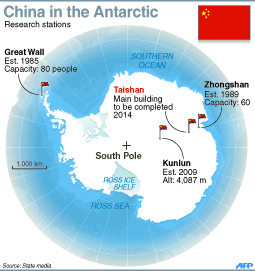Sunday Times 2
Antarctica may have a new type of ice: diamonds
View(s):OSLO (Reuters) – A kind of rock that often contains diamonds has been found in Antarctica for the first time, hinting at mineral riches in the vast, icy continent — where mining is banned.
No diamonds were found, but researchers said they were confident the gems were there.
“It would be very surprising if there weren’t diamonds in these kimberlites,” Greg Yaxley of the Australian National University in Canberra, who led the research, said in a telephone interview.
Writing in the journal Nature Communications, an Australian-led team reported finding the kimberlite deposits around Mount Meredith, in the Prince Charles Mountains in East Antarctica. Kimberlite is a rare rock where diamonds are often found; it is named after the South African town of Kimberley, the site of a late 19th-century diamond rush.
That does not mean Antarctica will soon see its own diamond rush. Antarctica is not only forbiddingly cold and remote but also protected by a treaty that preserves the continent for scientific research and wildlife, from penguins to seals. The 1991 environmental accord banned mining for at least 50 years.
“I don’t think it’s terribly practical that anyone could actually explore successfully and, personally, I hope that mining does not take place,” Yaxley said.
Others geologists doubted the find held much commercial value. Less than 10 percent of the deposits of similar kimberlite are economically viable, said Teal Riley of the British Antarctic Survey. “It’s a big leap from here to mining,” he told Reuters.
Extended ban
The Antarctic Treaty is binding only on its 50 signatories, but it has the backing of major powers, including the United States and China. Many expect the ban on mining to be extended in 2041.
“There is likely to be little opposition to an extension of this prohibition, despite the potential discovery of a new type of Antarctic ‘ice’,” Nature Communications said in a statement.
But another expert said the future was not so clear. Gold, platinum, copper, iron and coal have also been found in Antarctica. And diamonds are already mined today in some of the world’s colder reaches of northern Canada and Siberia.
“We do not know what the Treaty parties’ views will be on mining after 2041 or what technologies might exist that could make extraction of Antarctic minerals economically viable,” said Kevin Hughes, of the Scientific Committee on Antarctic Research.
Riley said there was a fine line between geological mapping and prospecting with an eye to mining. Russia, Ukraine and China, among other countries, have been more active in surveying Antarctica in recent years.
And demand for diamonds is likely to outpace supply in coming years. Few new mines are being discovered to provide the newly wealthy in countries such as China with Western-style jewellery. The last major find was Rio Tint’s Murrow mine in Zimbabwe in 1997.
Diamonds are formed under immense heat and pressure around 100 miles down, in the molten rock of Earth’s mantle. Millions of years later, they are brought to the surface in powerful eruptions and preserved in the distinctive igneous rock formations called kimberlites.
The kimberlite deposit is also confirmation of how continents drift. The region of East Antarctica was once part of a continent known as Gondwanaland, connected to what is now Africa and India, which also have kimberlite.

